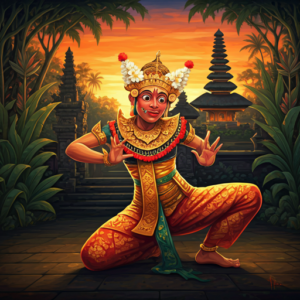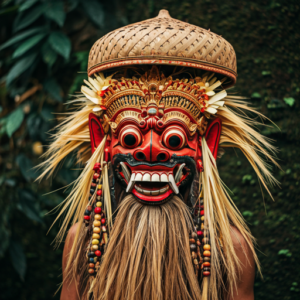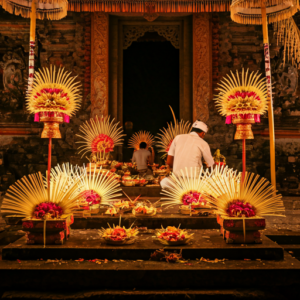
Balinese textiles are not merely fabrics; they are repositories of tradition, culture, and history. Woven with intricate designs and vibrant colors, these textiles tell stories of ancient rituals, religious beliefs, and artistic mastery. From ceremonial garments to everyday wear, Balinese textiles play a central role in the island’s social, cultural, and economic life.
The Art of Balinese Weaving
Weaving is a time-honored tradition in Bali, passed down through generations of skilled artisans. Traditionally, weaving was primarily the domain of women, who would learn the craft from their mothers and grandmothers. Today, while men are also involved in weaving, it remains an essential part of Balinese women’s identity and cultural heritage.
Balinese textiles are created using various techniques, including handloom weaving, ikat dyeing, and batik printing. Each technique requires precision, patience, and a deep understanding of traditional motifs and patterns. The resulting fabrics are prized for their quality, durability, and exquisite beauty.
1. Ikat Weaving: Tying and Dyeing
Ikat weaving, known locally as „geringsing,“ is one of the most distinctive textile traditions in Bali. This intricate technique involves dyeing the threads before they are woven into fabric, creating patterns that appear blurred or fuzzy at the edges. The process requires meticulous attention to detail, as artisans carefully tie and dye the threads to achieve the desired design.
Geringsing textiles are traditionally used for ceremonial purposes, such as weddings, temple rituals, and coming-of-age ceremonies. The motifs found in geringsing fabrics often carry symbolic meanings related to Balinese cosmology, mythology, and spiritual beliefs.
Batik Printing: Wax and Dye
Batik printing is another traditional technique widely practiced in Bali. In this method, hot wax is applied to the fabric using a special tool called a „canting“ to create intricate designs. The wax acts as a resist, preventing the dye from penetrating certain areas of the fabric. After the wax has dried, the fabric is dyed, and the wax is removed to reveal the pattern.
Balinese batik often features floral motifs, geometric patterns, and mythological symbols, reflecting the island’s natural beauty and cultural heritage. While batik was historically used for ceremonial and ritual purposes, it has evolved into a popular form of everyday attire and decorative art.
Traditional Textiles in Balinese Culture
Balinese textiles are deeply intertwined with the island’s culture, religion, and social customs. They play a central role in important life events, ceremonies, and rituals, serving as markers of identity, status, and belonging.
Ceremonial Garments: Symbols of Status and Tradition
Balinese ceremonies, such as weddings, temple festivals, and cremation ceremonies, are elaborate affairs steeped in tradition and symbolism. Traditional textiles play a crucial role in these ceremonies, with specific garments worn to signify the participants’ roles, status, and cultural affiliations.
For example, the „kamen“ is a traditional waistcloth worn by men during temple rituals and ceremonies. Made from handwoven ikat or songket fabric, the kamen is often embellished with intricate motifs and designs that reflect the wearer’s social status and religious beliefs.
Similarly, women wear elaborately woven „kebaya“ blouses paired with sarongs and sashes during important ceremonies. These garments are often passed down through generations as heirlooms, carrying with them the stories and memories of past generations.
Everyday Wear: Expressions of Identity and Creativity
While traditional textiles are still worn for ceremonial occasions, Balinese people also incorporate them into their everyday attire. Sarongs, in particular, are ubiquitous in Balinese society, worn by both men and women as practical and versatile garments.
Sarongs come in a variety of colors, patterns, and fabrics, ranging from simple cotton to luxurious silk. They are worn for everything from going to the market to attending religious ceremonies, reflecting the wearer’s personal style, taste, and social status.
Preserving Balinese Textile Traditions
Despite the modernization and globalization of Balinese society, traditional textile arts continue to thrive thanks to the efforts of local artisans, cultural organizations, and government initiatives. These efforts aim to preserve and promote Balinese textile traditions for future generations, ensuring that this rich cultural heritage remains alive and vibrant.
Artisanal Workshops and Cooperatives
Throughout Bali, there are artisanal workshops and cooperatives dedicated to preserving traditional weaving techniques and supporting local artisans. These organizations provide training, resources, and market access to weavers, enabling them to sustain their craft and earn a livelihood from their skills.
Cultural Festivals and Exhibitions
Cultural festivals and exhibitions play a vital role in showcasing Balinese textile arts to a broader audience. Events such as the Bali Arts Festival and Ubud Writers & Readers Festival feature exhibitions, workshops, and performances highlighting traditional weaving techniques and contemporary interpretations of Balinese textiles.
Education and Outreach Programs
Educational initiatives aimed at promoting awareness and appreciation of Balinese textile traditions are also gaining momentum. Schools, museums, and community centers offer classes, seminars, and guided tours that introduce locals and visitors alike to the history, techniques, and significance of Balinese weaving.
Conclusion
Balinese textiles are more than just fabrics; they are living expressions of tradition, creativity, and cultural identity. Woven with skill and imbued with symbolism, these textiles connect the past with the present, weaving together stories of ritual, belief, and belonging.
As Balinese society continues to evolve, so too do its textile traditions. Yet, amidst the changes and challenges of the modern world, the art of weaving remains a cherished practice, passed down from generation to generation with reverence and pride.
In preserving and celebrating Balinese textile traditions, we honor not only the artisans who create these exquisite fabrics but also the rich tapestry of culture and heritage that defines the island of Bali. Through their intricate patterns and vibrant colors, Balinese textiles continue to weave stories of tradition, resilience, and creativity for generations to come.





